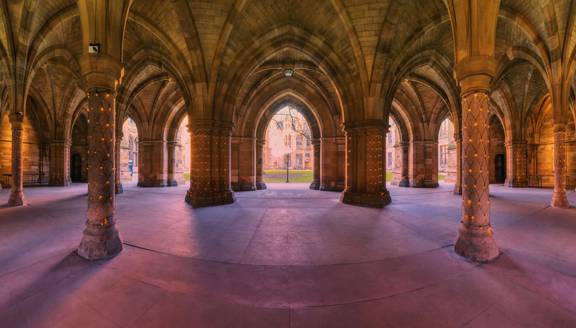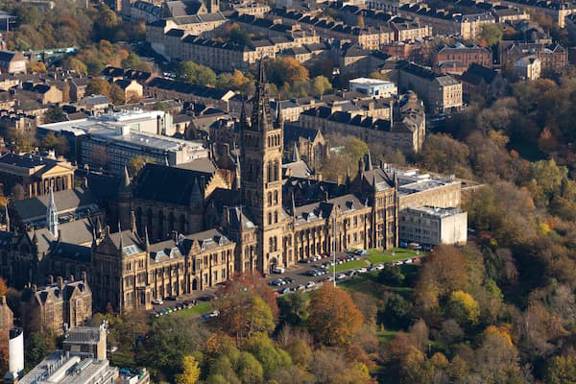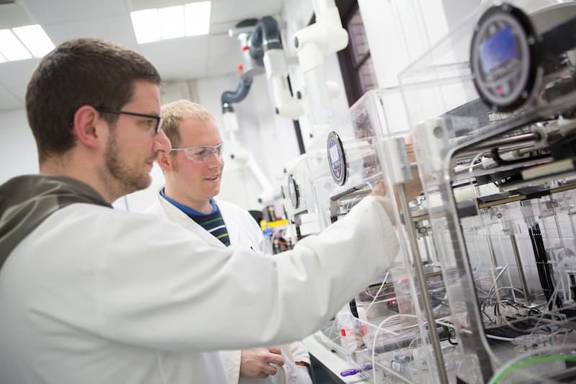13 ways University of Glasgow research is addressing the net zero challenge
20 Nov 2020 • 6 minute read
University of Glasgow research addressing the net zero challenge

From rewilding Arctic soils to self-healing construction materials and winged-devices that mimic fish tails, researchers at University of Glasgow’s Centre for Sustainable Solutions are developing new technologies and methods to help achieve ambitious net zero targets.
A catalyst for change
In 2019 the UK Government set a target that requires the UK to bring all greenhouse gas emissions to net zero by 2050. Achieving net zero requires a balance between reducing emissions where we cannot eliminate them, and "negative emissions" from activities such as active carbon removal and reforestation.
The University of Glasgow’s Centre for Sustainable Solutions is working in partnership with Glasgow City Council to achieve their ambitious net zero carbon target of 2030.
The partnership is bringing researchers, policymakers and practitioners together and using cities as catalysts for change.

An aerial view of the University of Glasgow
Some of the exciting research underway at the University of Glasgow
-
Hydrogen for heating
Over 80% of homes in the UK have gas central heating, generating up to a third of the UK’s greenhouse emissions. Hydrogen is now being considered as an alternative to natural gas to reduce emissions. To be able to use hydrogen in heating and household appliances, Professor Manosh Paul opens in a new window in the James Watt School of Engineering is working to produce renewable hydrogen and low-carbon hydrogen-rich syngas from biomass and waste. This research will tackle the challenges of combustion of these types of fuels for heating applications. This strongly ties in with the UK Government’s Clean Growth Strategy opens in a new window for the development of a low carbon future and the transition to hydrogen as a route to decarbonising heat.
-
Sustainable construction
Building and construction are responsible for 39% of all carbon emissions in the world. Dr Cise Unluer opens in a new window in the Infrastructure and Environment Research Division in the James Watt School of Engineering is developing innovative and functional construction products with high performance and durability. Cise’s cement-based mixes incorporate waste materials, gain strength by absorbing CO2, can self-heal and are recyclable at the end of their lifetime. All of these support meeting the net zero targets via the development of a sustainable built environment.
-
Low cost, printable solar cells
Solar energy is a truly renewable energy source. To date the disadvantages of solar cells have included the high investment required to install them and lower power conversion efficiencies in low-light conditions (i.e. cloudy weather). Thanks to a class of materials called perovskites, which have a range of exciting properties, solar cells can be made at low cost, and are printable. These devices also match the performance of commercially available solar panels. They therefore require small capital investments for mass production, and are ideal for manufacture in the UK, helping to transition to a fully net zero energy economy. Dr Pablo Docampo’s opens in a new window research in the School of Chemistry is developing understanding of the materials to enable improved solar cell development.
-
Industrial by-products for carbon capture and storage (CCS)
There are many different methods used to capture and store carbon from the atmosphere. Dr John MacDonald opens in a new window in the School of Geographical and Earth Sciences is investigating how industrial by-products such as steel slag can be used. Slag is similar in many respects to natural rocks. He uses his geochemistry background and experience in chemical analysis and microscopy to understand CO2 capture-chemical reactions and calculate the volumes of CO2 that can be captured by slag.
-
Energy efficiency in manufacturing
Manufacturing facilities and systems use a significant share of the energy in the UK and globally. Dr Ying Liu opens in a new window in the James Watt School of Engineering is generating data-driven and hybrid models for a digital twin to understand the energy consumption patterns of manufacturing and other facilities and manufacturing systems. These models deliver energy consumption and carbon emission predictions, the data is used to provide algorithms to improve energy efficiency, productivity, and system resilience.
-
Geothermal energy
Heating, including industrial processes, accounts for 37% of UK carbon emissions. Only 7.5% of heating and cooling in the UK is generated from renewables. Professor Gioia Falcone opens in a new window , Rankine Chair in Energy Engineering and Associate Director of the Centre for Sustainable Solutions is leading research on the sustainable use of geothermal resources as a strategic balancer in smart multi-source, multi-product energy systems, to maximise their resilience and minimise their carbon footprint.
-
Ammonia – a carbon-free fuel
The development of the Haber Bosch Process was a landmark achievement of the 20th century which can be directly credited to feeding 40% of the global population through provision of an accessible route to synthetic fertiliser. The current global rate of ammonia production exceeds 170MT per annum and is continuing to grow. When consideration is given to the entire process, including the generation of reaction feedstock, the Haber Bosch Process accounts for 1-2% of global energy demand.
The hydrogen required for the process is generally derived from fossil sources and the process accounts for more than 1% of manmade CO2 emissions. Professor Justin Hargreaves’ opens in a new window research group in the School of Chemistry is focused on the design of alternative ammonia synthesis catalysts which could be operated in localised units. An example, such as fertiliser could be produced close to its point of use from renewable energy sources and making the process carbon free. Such a development could also benefit those in remote and less industrialised locations of the world, as well as adding to the increasingly recognised potential of ammonia as a carbon-free fuel.
-
Energy harvesting – wind and hydro
Net zero targets can only be achieved through a mix of strategies using renewable sources at different scales. Dr Kiran Ramesh opens in a new window in the Division of Aerospace Engineering in the James Watt School of Engineering, is developing novel energy-harvesting mechanisms such as oscillating wings mimicking fish tails. At small and medium scales these devices can be more efficient and environmentally friendly than conventional horizontal axis wind or hydro turbine designs. Kiran’s designs are targeted at small-scale, off-grid applications, for example, a house, or for a small rural community.
-
Bioenergy
Bioenergy can help to reduce carbon emissions while producing energy. In the James Watt School of Engineering, Dr Ian Watson’s opens in a new window research on biomass thermochemical processing, specifically pyrolysis and gasification, offers routes towards negative carbon emissions and production of electricity, heat, hydrogen, and methane. His research on process scaling of microalgae provides a range of benefits, including efficient carbon capture and storage (CCS) and carbon capture and utilisation (CCU) and production of specific proteins, functional foods, platform chemicals, and even bioplastics.
-
Retrofitting Glasgow tenements to meet carbon reduction targets
Through economic and building performance evaluations, Professor Ken Gibb opens in a new window in the College of Social Sciences and partners are developing a plan to retrofit traditional Glasgow tenement buildings. The aim of the project, funded by the Scottish Funding Council, is to provide transferable learnings about how to achieve EnerPHit retrofit (one of the most stringent and integrated standards available internationally for energy retrofits) and carbon reduction targets across the city’s iconic sandstone tenements.
-
Carbon storage and release from Arctic soils
Soils in Arctic ecosystems make up half of the total global soil carbon pool. They therefore have great potential to control the climate, depending on whether they remove or release carbon in the future. Dr Mark Garnett opens in a new window , at the Scottish Universities Environmental Research Centre is part of a joint UK-Swedish team working on the PRIMETIME project opens in a new window . PRIMETIME aims to understand whether increasing the number of trees and shrubs in the Arctic will change the amount of carbon stored in the soil. Mark is overseeing the radiocarbon analytical aspects of the project.
-
Modelling and prediction critical to meeting net zero targets
Technologies and interventions alone are not enough to achieve net zero targets. If we can’t measure and model how on target, or not, we are, then we can’t plan the necessary interventions or make choices between them to achieve them.
The research of Professor Marian Scott opens in a new window and colleagues in the School of Mathematics and Statistics opens in a new window is adding value to a net zero data and analytics infrastructure.
Such an infrastructure will include ubiquitous sensors and satellite observations and other data streams which need to be merged to provide meaningful intelligence to allow them to be embedded in management support systems with fully quantified uncertainty. And it will add value to solutions delivering net zero, allowing progress to be tracked, as well as supporting decisions being made concerning the efficiency of alternative interventions.
-
Harnessing the power of microorganisms to decarbonise the water sector
19th century engineers transformed public health in Western cities, developing infrastructure to deliver clean water to our home and to remove and treat wastewater. This infrastructure has served us well but operating it accounts for more than 5 million tonnes per year of carbon emissions in the UK. This is greater than the annual output from a large coal-fired power station. It is least sustainable in rural communities, both in the UK and in the developing world, where the need for clean water and sanitation is at its greatest.
Professor William Sloan opens in a new window and water researchers in the James Watt School of Engineering are harnessing the power of microorganisms to deliver clean drinking water and treat wastewater in rural communities using low-energy, sustainable, off-grid technologies. In October 2020 Professor Sloan was awarded a 10-year Royal Academy of Engineering Chair in Emerging Technologies to tackle the most pressing global water problems and help decarbonise the water industry.
A collaborative approach
One of the pillars of the University’s new research strategy is collaboration. It recognises the importance of partnership to develop sustainable solutions, deploy technologies, drive change, and achieve the ambitious net zero targets.
The Centre for Sustainable Solutions opens in a new window , launched in April 2020 brings together individuals, communities, and organisations to work together to act towards a sustainable future. The Centre delivers sustainable solutions across all sectors, with a focus on the climate emergency. The University welcomes approaches from new partners to work together to deliver change.

Researchers at University of Glasgow
You might also be interested in
-
Offshore wind opportunities
Boasting one of Europe’s largest offshore Renewable Energy Zones, Scotland is the natural location for your offshore wind project.
-
5th Industrial Revolution
Wind, sea and the right chemistry...why Scotland is poised to play a significant role in Europe's sustainable energy production to help tackle climate change.
-
Renewable energy skills
Jim Brown, Director of ESP, shares his thoughts on how Scotland is reshaping its energy skills landscape to meet challenges and opportunities across the UK and globally.
